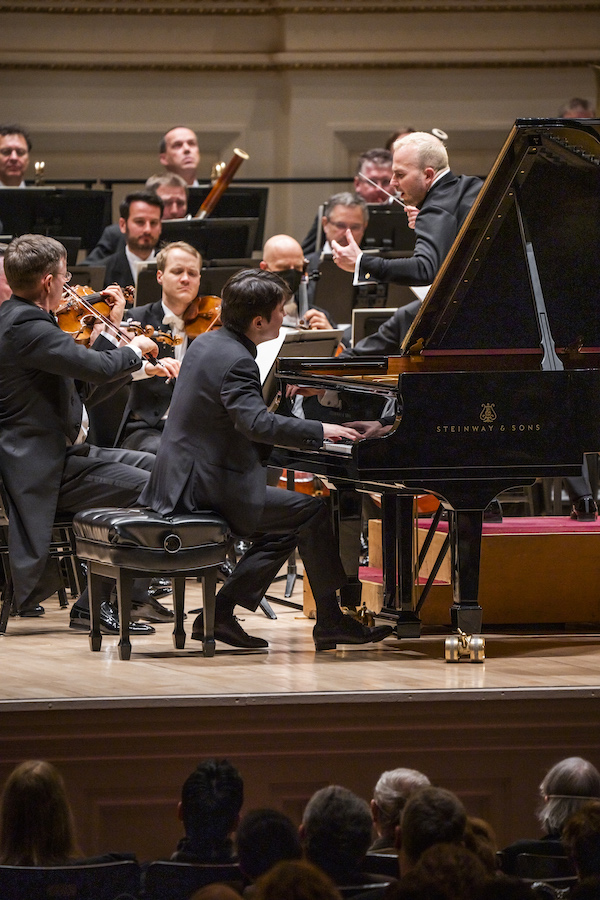Putin friends jettisoned, the Vienna Philharmonic opens Carnegie weekend with energy and defiance

Classical music is generally seen as a cloistered art form—which many on the inside may feel is good for the “brand”—something that is neither advantageous within the overall culture, nor even possible. Those who make and play the music have always existed in the world and been a part of history. Anyone who might still be skeptical of that has only to consider the Vienna Philharmonic Orchestra’s appearance Friday night in Carnegie Hall.
The VPO has been visiting Carnegie for decades, and after an interruption from the pandemic is back for three concerts across the weekend. They were scheduled to be led by Valery Gergiev, and pianist Denis Matsuev was to play Rachmaninoff’s Piano Concerto No. 2. But then Russia invaded Ukraine, and the two musicians, who are public supporters and friends of Russian president Vladimir Putin immediately became personas non grata on the international stage.
So Gergiev and Matuev—who have for years been the target of leafletting and protests outside concert halls—were jettisoned by Carnegie Hall on Thursday. (Gergiev has also been essentially suspended from his posts with the Rotterdam and Munich orchestras, and Carnegie canceled the May concerts with his Mariinsky Orchestra.)
Yannick Nézet-Séguin was the podium stand-in for this weekend. Pianist Seong-Jin Cho flew in from Berlin and arrived Friday afternoon with no time to spare. And so the show, an all-Rachmaninoff affair that also included his Symphony No. 2, went on.
And a good show it was. What it lacked in nuance and refinement—with what could only have been limited rehearsal and Nézet-Seguin’s generally narrow view of interpretation—made up for the rough edges with a sense of positive determination, a touch of grit, and mountainous energy.
Much of that came from the audience, which greeted conductor and soloist with a vocal, joyous ovation when they first stepped out on stage. One felt this was not just anticipation for the music to come, but the expression of a multiethnic community coming together to support and celebrate creative culture, adding things to the world, and against atavistic destruction. Excitement was in the air.
To this, Cho brought forceful and complex expression. From the opening chords of the piano concerto, his touch was skillful and clear, and behind it one felt a substantial weight of feeling and purpose, like he was pulling along something massive and meaningful. His playing had the kind of sinewy strength that makes burdensome things seem light, even as one sensed the effort.
Cho’s phrasing was impressively supple. He and the orchestra fully coordinated the pulse of the music—at times it seemed Cho was deferring to the ensemble as to where the beat was—and he found space in between for rubato and changes in dynamics. The speed and power the music demands was there, and Cho played with a companionable independence between right and left hand, more of a dialogue than one usually hears. He played inside the music, which is already so extroverted and public-facing that, rather than the spectacle, one heard the beauty and possible meanings.
While the coordination in time between Cho and the orchestra was fine, balances often were off—every fortissimo passage swamped the piano in an overall mass of sound. One imagines that the last-minute nature of the concert was responsible for this, but it was also consistent with Nézet-Seguin’s recent concert appearances. The conductor puts energy, as delivered through mass and volume, up front. He seems to relish the warm acoustic of Carnegie Hall, and used the orchestra to fill every nook and cranny with sound.
At times this was thrilling and satisfying, at others overwhelming and confusing. This was especially the case with Symphony No. 2, which was like a thunderstorm followed by a tornado, with a hurricane to provide a brief eye of calm before blowing away everything that was left.
The string sound was lush at the beginning, and there was deep feeling in the playing. But once the music grew in pace and intensity, Nézet-Séguin brought it to a peak and keep it there. Every climax was climactic in the ultimate sense. The symphony is full of expressive peaks and valleys, but every peak was the same height and the valleys were not that deep.
The Adagio proved somewhat of an exception, feeling stable and complex for awhile. This also featured gorgeous and moving playing from the clarinet section, which was a star all night. But that was the only nuance in a sonic palette that, all evening, was like the lens flare in Cool Hand Luke on an endless loop. And eventually, Nézet-Séguin brought the music to what was the highest and loudest peak of the night. That miscalculation lessened the effect of the actual finale.
One is more than glad to hear the VPO in person again, and making music in the current international circumstances is important and valuable. If the sense of meaning and urgency pushed conductor and orchestra into a blunt instrument, one knows that the intentions of all involved were well meant.